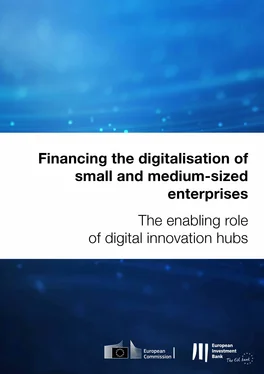Foreword by Lilyana Pavlova
Foreword by Roberto Viola
Executive summary
Context and study approach
Snapshot of the status of digitalisation in Europe
Key findings
Recommendations
Recommendations focused on supporting the ecosystem
Recommendations focused on access to finance
1.Context and study approach
1.1Context
1.2Approach
1.3Methodology
2.Snapshot of the status of digitalisation in Europe
2.1Trends of digitalisation in Europe and expected growth
2.2The digital profile of small and medium-sized enterprises: Digital adopters and digital natives
2.3Ecosystem and enablers for innovation and digitalisation
2.4Ecosystem and enablers for innovation and digitalisation: Overview of national and European programmes
2.5Selected examples of digitalisation programmes worldwide
3.Key findings
3.1Finding 1: Digital innovation hubs are critical enablers with strong potential to strengthen their offerings
3.2Finding 2: Public funding is dominant in digital innovation hubs, but new financing models are emerging
3.3Finding 3: Perceived complexity and low visibility limit demand for funding from public digitalisation programmes
3.4Finding 4: A key barrier to digitalisation of small and medium-sized enterprises (different manifestation for natives versus adopters) is the lack of knowledge
3.5Finding 5: Financing of digital projects is limited by the knowledge gap of banks
4.Recommendations
4.1Recommendation 1: Strengthen digital innovation hubs’ reach and role in helping small and medium-sized enterprises to access financing support
4.2Recommendation 2: Diversify funding sources where possible and support digital innovation hubs to develop more commercially-oriented business models
4.3Recommendation 3: Develop a central platform to drive awareness and ambition
4.4Recommendation 4: Develop a voucher scheme to provide technical assistance to small and medium-sized enterprises and a marketplace to facilitate match-making
4.5Recommendation 5: Explore the development of dedicated financial instruments to support digitalisation
4.6Recommendation 6: Consider developing dedicated equity instruments and/or higher risk-absorption debt products for growth capital to support disruptive digital technologies
4.7Recommendation 7: Further investigate opportunities for dedicated financial instruments and dedicated advisory services for the CESEE region
List of figures
List of tables
About the European Investment Bank
The European Investment Bank is the world’s biggest multilateral lender. The only bank owned by and representing the interests of the EU countries, the EIB finances Europe’s economic growth. Over six decades the Bank has backed start-ups like Skype and massive schemes like the Øresund Bridge linking Sweden and Denmark. Headquartered in Luxembourg, the EIB Group includes the European Investment Fund, a specialist financer of small and medium-sized enterprises.
Financing the digitalisation of small and medium-sized enterprises
The enabling role of digital innovation hubs
Prepared for:
The European Commission (DG Connect and DG RTD)
By:
Innovation Finance Advisory, European Investment Bank
Authors: Alberto Casorati, Arnold Verbeek
Supervisor: Shiva Dustdar
Contributions from Po Wen Liu, Maria Lundqvist (Project Directorate, European Investment Bank), Luuk Borg, Bjorn-Soren Gigler, Yves Paindaveine (DG Connect, European Commission)
This report was produced with funding from the European Union, through the European Investment Advisory Hub
Contact: innovfinadvisory@eib.org
Consultancy support: Gartner
Disclaimer
This Report should not be referred to as representing the views of the European Investment Bank (EIB), of the European Investment Advisory Hub (EIAH), of the European Commission (EC), or of other European Union (EU) institutions and bodies. Any views expressed herein, including interpretation(s) of regulations, reflect the current views of the author(s), which do not necessarily correspond to the views of the EIB, of the EIAH, of the EC, or of other EU institutions and bodies. Views expressed herein may differ from views set out in other documents, including similar research papers published by the EIB, the EIAH, the EC, or other EU institutions and bodies. Contents of this Report, including views expressed, are current at the date of publication set out above, and may change without notice. No representation or warranty, express or implied, is or will be made, and no liability or responsibility is or will be accepted by the EIB, the EIAH, the EC, or other EU institutions and bodies in respect of the accuracy or completeness of the information contained herein, and any such liability is expressly disclaimed. Nothing in this Report constitutes investment, legal, or tax advice, nor shall be relied upon as such advice. Specific professional advice should always be sought separately before taking any action based on this Report. Reproduction, publication, and reprint are subject to the authors’ prior written authorisation.
| Foreword |
|
 |
The effect of the coronavirus pandemic on the European and global economies is significant. While the Digital Revolution was well under way globally, the pandemic has led to the wide recognition of the importance of digital transformation for our immediate economic recovery and future resilience. Internet of things, 5G, big data, blockchain technologies and artificial intelligence can help us achieve greater supply-chain transparency and flexibility, increase data security, strengthen remote workforces and automate manual processes. Digital technologies can also help us in our fight to reduce greenhouse gas emissions and enable Europe to be the first climate-neutral continent by 2050, as encapsulated in the objectives of the European Green Deal.
In this context, it is unfortunate that European industry currently operates below its digital potential. This is particularly true for our small and medium-sized enterprises, which, because of their high vulnerability to supply and demand shocks, have been disproportionately affected by the coronavirus pandemic. In fact, the opportunity for economic recovery and future growth through digitalisation in Europe’s largest industrial segment is significant. This is why I am particularly pleased with the timely publication of this study, which discloses the ongoing policy discussions under the InvestEU and Digital Europe programmes. These are discussed with reference to the European Union’s response to the pandemic.
The study proposes a clear path forward. Europe’s digitalisation journey can accelerate if we strengthen our current innovation and digitalisation ecosystem and empower the role of digital innovation hubs. Specifically, these digital innovation hubs should coordinate support to companies within local industrial ecosystems. They should develop central knowledge-sharing platforms and provide technical and financial advice, enhancing their cooperation with the financial community to guide European entrepreneurs throughout their financing journey.
Читать дальше













